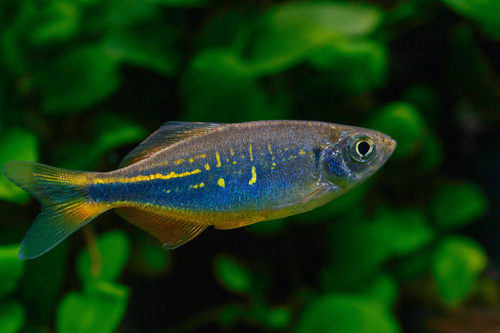Giant danios call the freshwater’s of southeast Asia their home, but have quickly become one of the more popular fish to keep in home aquariums for a couple of different reasons.
Very active and super playful, these fish also happen to be some of the best looking hobby fish you can add to your home aquarium set up – and are easy enough to care for as a beginner, too.
As far as the look of these fish are concerned, you’re talking about a slender and almost elongated body shape with a horizontal stripe that runs the entire length of their body – breaking up their “two-tone” color scheme. These fish have a very distinctive blue and silver coloring that becomes more and more pronounced as they get older, to the point where they start to shimmer and shine in almost any lighting conditions.
A decently sized fish to be sure (they can grow to be up to 6 inches long and sometimes longer at full maturity) these fish will require a larger tank and lots of swimming space. But we’ll get deeper into that and the ideal giant danios tank mates in just a moment.
Giant danios have a reputation for being very peaceful and capable of coexisting with all kinds of other “community fish”. The only thing you have to be a little bit careful about is adding a lot of smaller or more passive fish into your aquarium. Those fish are the most likely to get bullied by these otherwise friendly and happy-go-lucky underwater creatures.
Easy enough to get your hands on at any local aquarium shop, you’re not going to have to spend a small fortune on Giant danios, either. They have an exotic look and add a lot of character to your tank, though!
Below we go into the ins and outs of (almost) everything you want to think about when it comes to adding the best Giant danios tank mates into the mix.
Let’s get started!
Contents
What to Know about Giant Danios
Well-regarded for their very active and playful lifestyle, Giant danios are going to spend almost every waking moment of their lives zipping around your tank and playing with any of their companions.
Easy to care for, easy to love, and easy-going enough with a whole bunch of other fish species you might want to throw into the mix, they make fantastic companion fish (as long as you pair them off with the right species).
Temperament
First and foremost, you’ll be glad to know that these fish have a very relaxed temperament around other fish even if they are really energetic and pretty “go-go” all on their own. These fish do like to live in smaller schools (you want to keep six or more together at a minimum), though.
It’s really important to make sure that they get lots of socialization in. If they don’t have a lot of other fish to play with or interact with they can become stressed out and unwell.
Other than that, though, you don’t have a whole lot to worry about from a temperament standpoint.
Average Size
While these fish can grow to be anywhere between four and 8 inches long, the average size for a fully mature Giant danios sits at about 6 inches. That makes them one of the larger freshwater fish you can keep in a home aquarium, and it also means they are going to need a little bit extra water to swim around in – especially when you consider how active they are.
Competition
It would be impossible to overstate just how active these fish are from a swimming standpoint. They like to bop around the tank (usually in the upper water columns), but they aren’t particularly competitive – except with much smaller or much more passive fish.
The only time you want to keep your eye on Giant danios from a competitive perspective is when feeding time rolls around. Try to avoid feeding these fish at the same time you feed more passive fish, slower moving fish, or fish with longer fins.
Water Parameters ; Tank Setup
A lot of first-time Giant danios owners are surprised to learn just how adaptive these fish are to a variety of different water conditions.
At the same time, these fish do have a “sweet spot” temperature and pH range that they prefer. Anything between 72°F and 82°F suits them right down to the ground, and a pH range between 6.5 and 7.5 will keep them really happy.
Because they are on the larger side of things (and because they like to swim so actively) you’ll want to try to give them at least 30 gallons of water to swim around in. And that’s just for one of these fish. An extra 10 gallons of water for every other danios you add into the mix will go a long way.
It’ll be even better if you can add a moderate to stronger current in your tank, too. A powerhead or canister filter with a stronger output will give them something to actively swim against, and will keep them really happy and healthy.
All in all, these fish are popular because they are easy to care for, a lot of fun, and bring a tremendous amount of personality to your underwater environment. You have to be a little bit careful when picking companion fish for their aquarium, but (by and large) these fish get along with pretty much everybody if they have space to swim around in.
15 Best Giant Danios Tank Mates
Check out our other similar posts in this category:
1. Angelfish
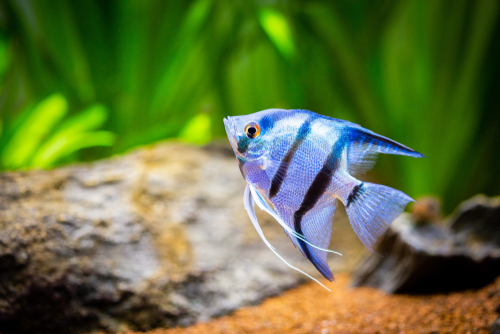
- Scientific name: (Pterophyllum scalare)
- Average adult size: 6 inches
- Care level: Moderate
- Place of origin: South America
Angelfish make a perfect companion tank mate for Giant danios because of their peaceful and friendly personality. It doesn’t hurt that these fish are about the same size as mature giant danios, either – or that they like almost identical tank conditions, too.
Pros of keeping with giant danios
- Relaxed, easy going, hardy
Cons of keeping with giant danios
- Too slow moving to compete for food with giant danios
2. Gouramis
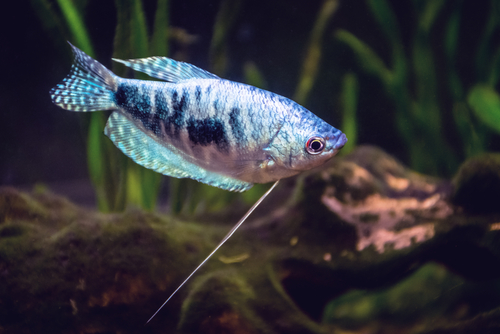
- Scientific name: Trichogaster spp
- Average adult size: 3-4 inches
- Care level: Easy to moderate
- Place of origin: Southeast Asia
Though slightly smaller than Giant danios, these fish have the ability to zip away from even the fastest moving fish – and that’s going to break up a lot of fights. These fish are peaceful, playful, and friendly and aren’t shy about schooling up with Giant danios, either.
Pros of keeping with giant danios
- Playful and friendly, tolerate varied water conditions
Cons of keeping with giant danios
- Can outcompete fish for food, sometimes turn aggressive
3. Swordtails
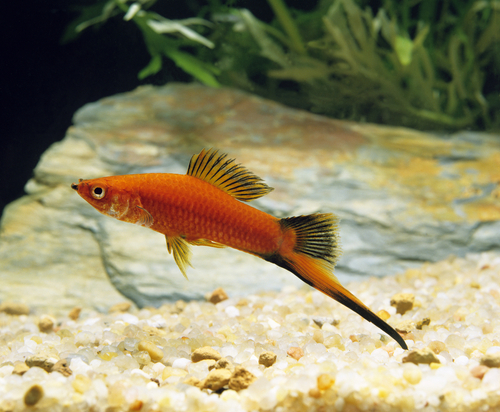
- Scientific name: Xiphophorus helleri
- Average adult size: 4 inches
- Care level: Easy
- Place of origin: Central America
One of the more “universal” companion fish options out there in the home aquarium space, these fish are easy to take care of, close to the same size as Giant danios, and will be able to keep pace with these fast moving fish.
Pros of keeping with giant danios
- Easy to care for, tolerable of different water conditions
Cons of keeping with giant danios
- Frequent breeding can overpopulate a tank
4. Platies
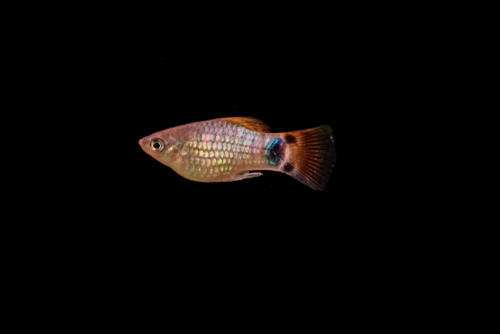
- Scientific name: Xiphophorus maculatus
- Average adult size: 3 inches
- Care level: Easy
- Place of origin: Central America
Though they are certainly on the smaller side of things (and sometimes it is better to shy away from smaller fish with Giant danios), these fish are fast, friendly, and can hold their own. You won’t have to worry about them.
Pros of keeping with giant danios
- Community minded fish that get along well with everyone
Cons of keeping with giant danios
- Might require a bigger tank because of their size
5. Corydoras

- Scientific name: Corydoras spp
- Average adult size: 2-3 inches
- Care level: Easy
- Place of origin: South America
The best thing about these fish – and a great reason you want to add them to your Giant danios tank – is that they live almost exclusively in the lower water column. Bottom dwelling fish, they are natural filters and will keep the water healthy for all your other fish.
Pros of keeping with giant danios
- Compatible with giant danios water conditions
Cons of keeping with giant danios
- Sometimes will fight for food with giant danios
6. Tetras
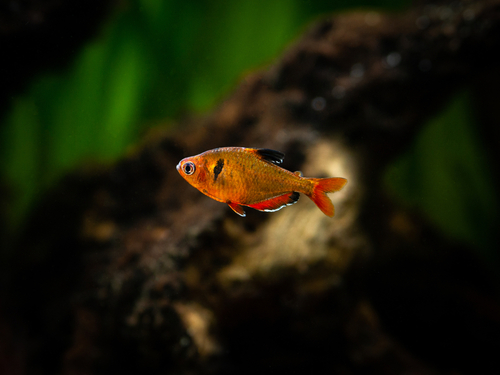
- Scientific name: Hyphessobrycon spp
- Average adult size: 1-2 inches
- Care level: Easy to moderate
- Place of origin: South America
Almost every kind of tetra under the sun makes for a great companion fish with Giant danios. These fish are small, to be sure, but they aren’t pushovers and have the “moves” to escape Giant danios that get low fresh.
Pros of keeping with giant danios
- Calm and relaxed, capable of living in different water columns in the tank
Cons of keeping with giant danios
- Will sometimes grow quite large and require more tank space
7. Rainbowfish
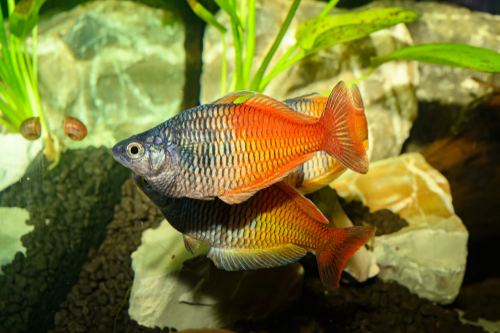
- Scientific name: Melanotaenia spp
- Average adult size: 2-4 inches
- Care level: Easy to moderate
- Place of origin: Australia, New Guinea, and nearby islands
These fish swim mostly in the middle to upper water columns of your tank, but they are perfectly fine dipping down into the lower levels if Giant danios begin to get prickly. They’ll add a lot of color and a lot of personality to your tank.
Pros of keeping with giant danios
- Enjoy the same kind of water conditions as giant danios, live in different water columns to keep the peace
Cons of keeping with giant danios
- Strong competition for food, smaller rainbowfish might get eaten by giant danios
8. Rasboras
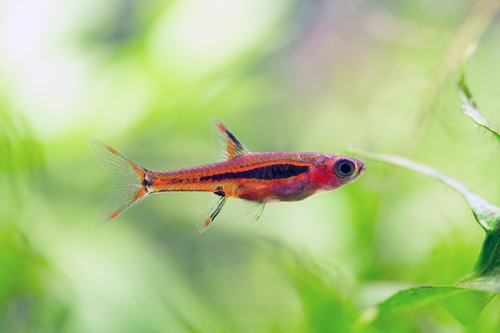
- Scientific name: Boraras spp
- Average adult size: 1-2 inches
- Care level: Easy
- Place of origin: Southeast Asia
As peaceful as they come, these fish aren’t passive. They have a life of their own and aren’t going to get bullied by Giant danios.
Pros of keeping with giant danios
- Cordone off in their own area of the tank, peaceful
Cons of keeping with giant danios
- Grow to larger sizes, requiring a tank upgrade
9. Bristlenose Plecos

- Scientific name: Ancistrus spp
- Average adult size: 4-6 inches
- Care level: Easy
- Place of origin: South America
Close to the same size as full grown Giant danios, these fish do a great job keeping your tank clean while working as a natural filter. They stick to the bottom of the water column as well, so there’s not going to be a lot of opportunity for Giant danios to get upset with these fish.
Pros of keeping with giant danios
- Help keep tanks clean and free of algae
Cons of keeping with giant danios
- Sometimes produce a lot of waste, requiring water swaps
10. Kuhli Loaches
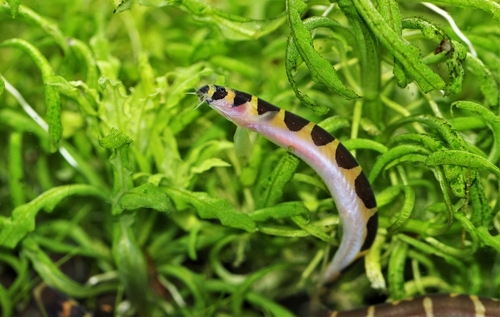
- Scientific name: Pangio kuhlii
- Average adult size: 3-4 inches
- Care level: Moderate
- Place of origin: Southeast Asia
Another bottom dwelling fish that will sometimes pop up into the middle water column and play with your Giant danios, you don’t have to work hard to keep these fish happy, healthy, or getting along with other fish in your tank.
Pros of keeping with giant danios
- Fun, personable, friendly
Cons of keeping with giant danios
- Sensitive to water condition changes
11. Cherry Barbs
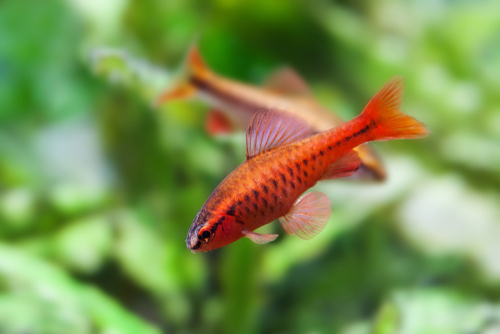
- Scientific name: Puntius titteya
- Average adult size: 2 inches
- Care level: Easy
- Place of origin: Sri Lanka
Very active – even more active than giant danios – these Cherry red fish are going to add pops of color to your underwater world and plenty of personality to match. You’ll love having them in your tank!
Pros of keeping with giant danios
- Love the same water conditions as giant danios
Cons of keeping with giant danios
- Might need a bigger tank as they grow, especially when kept in a school
12. Harlequin Rasboras
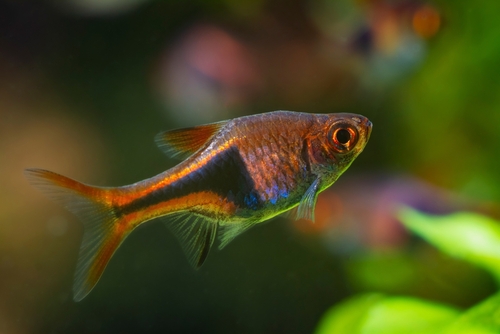
- Scientific name: Trigonostigma heteromorpha
- Average adult size: 2 inches
- Care level: Easy
- Place of origin: Southeast Asia
Available in a wide range of different colors (a rainbow, really), these high personality fish are easy to care for, like the same water conditions as Giant danios, and have the ability to escape if those fish get a little frustrated with them.
Pros of keeping with giant danios
- Easily live alongside giant danios, can escape quickly when needed
Cons of keeping with giant danios
- They like to school and become stressed when kept in small numbers
13. Neon Tetras
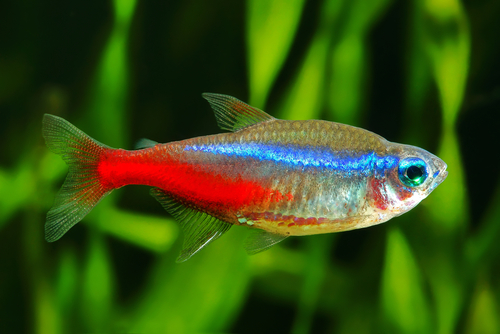
- Scientific name: Paracheirodon innesi
- Average adult size: 15 inches
- Care level: Easy
- Place of origin: South America
Peaceful but never passive, these fish are playful and love to school up with different kinds of fish – including Giant danios. He can’t go wrong with adding to your aquarium.
Pros of keeping with giant danios
- Fast enough to escape stressed out fish
Cons of keeping with giant danios
- Require more frequent water changes
14. Zebra Danios

- Scientific name: Danio rerio
- Average adult size: 2-3 inches
- Care level: Easy
- Place of origin: India
It should come as no surprise that another danios family member would get along with your “giants”, even if these fish are slightly on the smaller side of things. They like the same kind of water conditions and stronger currents that your giants will enjoy.
Pros of keeping with giant danios
- Thrive in identical water conditions
Cons of keeping with giant danios
- May become upset with larger fish crowding them
15. Cherry Shrimp
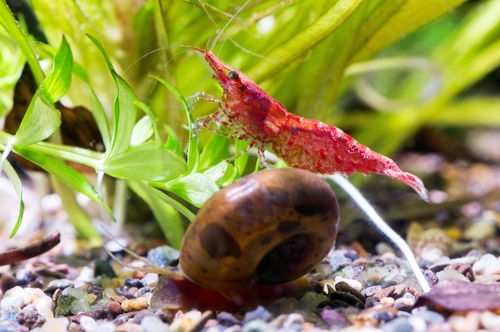
- Scientific name: Neocaridina davidi
- Average adult size: 1-2 inches
- Care level: Easy
- Place of origin: Taiwan
Cherry shrimp are a different kind of addition to your aquarium, but can spice things up a little bit if you’re interested in adding more than just fish to your tank. They won’t end up as food for your fish, either!
Pros of keeping with giant danios
- Live at the opposite end of the tank
Cons of keeping with giant danios
- Can get gobbled up by more aggressive fish in the aquarium
Summary
Peaceful, friendly, and playful, while Giant danios need a little bit of extra “real estate” to zip around in underwater finding perfect companions for your aquarium shouldn’t be an uphill battle.
Especially if you’re using the inside information we shared above!
Use the list of the 15 best giant danios tank mates we highlighted earlier and you’ll be able to find the perfect companions for your favorite fish with zero headache or hassle whatsoever.
Frequently Asked Questions
What is the recommended tank size for giant danios?
The bigger your aquarium the better when it comes to an active fish like Giant danios, but you want to set them up with at least 30 gallons of swimming space as the absolute minimum.
Can giant danios coexist with other fish in a community tank?
Absolutely! As we touched on a couple of times already, these fish are almost completely peaceful and really do well with communities of fish they can school up with. Things only get a little bit tricky when you add smaller (significantly smaller) or more passive fish into the equation.
What is the ideal water temperature range for giant danios?
Your Giant danios can handle all different kinds of water temperatures, but they really do the best (health and personality wise) when they have water temperatures between 72°F and 82°F.
What kind of water flow do giant danios prefer?
If you are able to give us fish a stronger current to swim against they are going to be really, really happy.
How many giant danios should be kept in a group?
These fish are in fact a school in fish and it’s best if you can keep them in bunches of six or more. You’ll reduce their stress, allow them to express their personalities to the maximum, and will keep them happier and healthier across the board.

Ian Sterling, founder of Fishlab.com, began his aquarium journey over 30 years ago, driven by a deep fascination for fish and their diverse personalities. His website, Fishlab.com, is dedicated to making fishkeeping accessible and enjoyable, offering beginner-friendly guidance, expert insights, and a community for aquarists to connect and share experiences.


